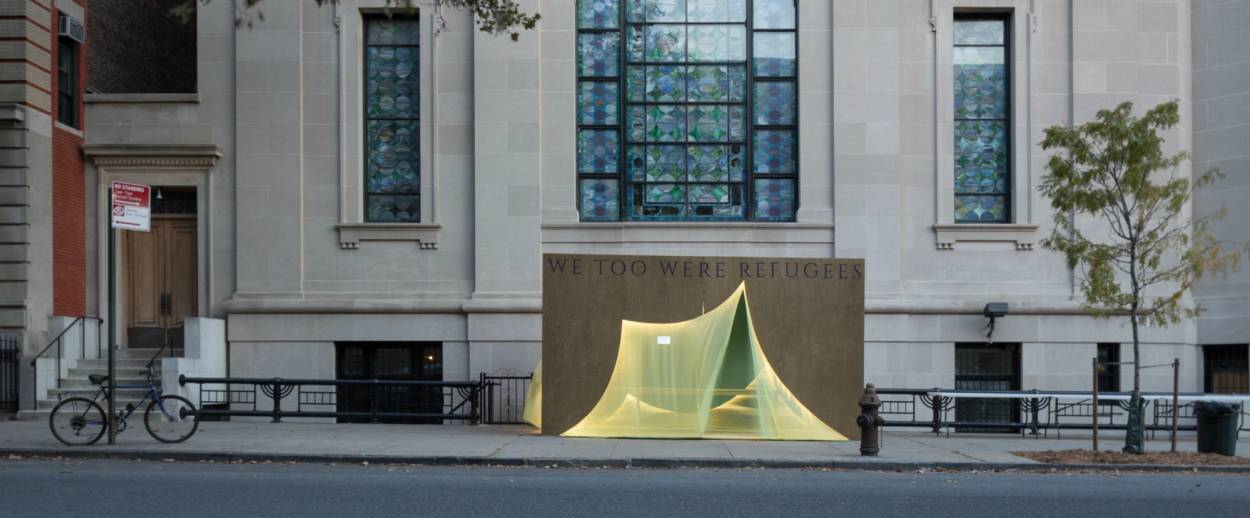The Sukkah as Metaphor: A Brooklyn Shul Addresses the Refugee Crisis
Congregation Beth Elohim pointedly welcomed a new generation of ‘ushpizin’




This autumn, with politics on everyone’s mind, Brooklyn’s Congregation Beth Elohim (CBE) decided to do something a little different for Sukkot. Explained Rachel Timoner, the synagogue’s rabbi, “Given the current national conversation, I was thinking about the fact that a sukkah has a dual message. It represents safety and protection, but also vulnerability. It’s a temporary shelter—a place for gathering with friends and community and sharing food—but also evidence that all of us are vulnerable to the forces of the world and dependent on God’s mercy.”
Timoner saw a direct parallel between the symbolism of the holiday and the world refugee crisis. “A sukkah is literally a refuge,” she pointed out. “It’s traditional to welcome ushpizin, honored guests. This year it felt particularly important for Jewish communities to say ‘We understand this experience; our grandparents and great-grandparents lived this experience.’ We should be out front saying to current refugees, ‘We want to make room for you.’ These families are our community’s ushpizin, and we hope they’ll soon find a real, sturdy home.”
CBE consulted on the project with HIAS (formerly the Hebrew Immigrant Aid Society), the world’s oldest refugee organization, which mobilizes the Jewish community in assisting refugees in Africa, Europe, the Middle East, Latin America, and the United States.The sukkah was built at the Beam Center, a construction and carpentry professional development program that serves low-income, minority, and immigrant teenagers in Brooklyn. The center donated the space, tools, and equipment. Shul members managed the project, worked with an architect, and helped with construction.

The resulting sukkah, right outside the shul in Park Slope, has external wooden walls carved with the Hebrew words bruchim ha’baim—colloquially, “welcome,” but literally meaning “blessed are those who come.” Another wall says in English, “We too were refugees.” A third says, “Welcome home.” The hut’s curvy walls, with billowing pale fabric draped inside its entryways to gently waft outward in the breeze, conveys the feeling of a tent.
Inside, three slideshows play simultaneously. One shares the stories of five actual refugees, including Rawan, a Syrian 4-year-old who lives with his mother and siblings in a former Saddam Hussein prison that is now a refugee camp. Under the auspices of the Rise Foundation, Rawan’s mom paints murals, to cheer up the walls of the camp. Visitors to the Sukkah also learn the stories of “Nicia” (a pseudonym), a Congolese woman who was sexually assaulted by a rebel soldier as a young teenager, and Kamal, a kid from Afghanistan whose family wandered for 17 years (not quite the biblical 40, but still impressive) before winding up in the San Damiano Friary in Northern California’s East Bay. “Who met us at the airport and found us this place to stay?” Kamal asks in the slideshow. “The Jewish Family Service of the East Bay. It’s really amazing—Muslims, Jews and Christians all coming together.”
The second slideshow offers facts and figures about the refugee crisis and asks the U.S. government to keep the gates of our country open to refugees. A third shares the story of Sukkot, using art by children in CBE’s religious school. The children of Israel are a people who have been enslaved and fled persecution in times both ancient and modern, the slideshow reminds us. A quote from Deuteronomy flashes: “My father was a wandering Aramean.”
CBE members can also get involved in the Tikkun Alliance, an advocacy committee with a branch dedicated to raising awareness and supporting refugees, and put together shoe boxes for Operation Refugee’s Hope Box Project, which collects toys, dolls, hard candy, rain ponchos, protein bars, toothbrushes, underwear, and socks for refugee kids. (And you needn’t be a CBE member to look up box-making instructions on Operation Refugee Child’s website and send supplies directly to children in need in Greek refugee camps. If you’re local, you can drop off a packed shoebox at CBE any time before October 30th. Great family project, I’m only saying.)
Last year, CBE’s sukkah featured a living wall, covered in plants, a reminder of our’ relationship to the living environment. It emphasized the ecological messages of the holiday. But this year, Timoner wanted to stress human connections. “We are not so different from these refugees,” she said emphatically. “We’ve been wanderers; we’ve been the victims of intolerance. Sukkot allows us time to recognize our own frailty and reminds us that, for so many, shelter remains impermanent. Today 65 million refugees and displaced people still wander the earth in search of a safe place to call home. There’s a natural link for empathy there. And the conversation about immigrants in this country is connected to anti-Muslim rhetoric, so the Jewish community has a role to play in saying ‘Let’s not judge all people by the actions of just a few.’”
Marjorie Ingall is a former columnist for Tablet, the author of Mamaleh Knows Best, and a frequent contributor to the New York Times Book Review.